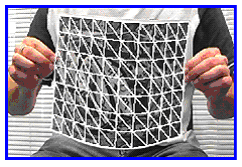Once again, Rouli at the Augmented Times has found another interesting set of videos. This time displaying a fascinating advance in augmented reality. So far, all AR, markerless or not, has been confined to using a 2D flat space as its jumping off point. The 3D shape can be anywhere based on the coordinate system the 2D shape uses, but they will have to recalculate the plane based on the 2D object location.
The breakthrough shown in these videos is the computer can understand a topographical object and then calculate the virtual object onto that topographical shape.
Slobodan Ilic explains how they use a triangulated mesh to create the 3D shape. By reducing the shape into a series of triangles they can reduce the overall size of the file, therefore making it easier to manipulate and apply AR to it. If you want to see a bunch more 3D mesh tracking you can find it here.

Technical jargon aside, this allows for some pretty cool stuff to be done with AR. Even the example video with the shirt looks amazing. It took until the broken occlusion part for me to figure what was the virtual object in the video.
As Rouli pointed out, the processing power needed is too much for the iPhone, so this breakthrough, while cool, is stuck on the desk computer for a while. I can think of a hundred and one uses if it could be run through the iPhone or using a future-technology like augmented vision, but for now we’ll have to wait for the rest of the technology to catch up.
